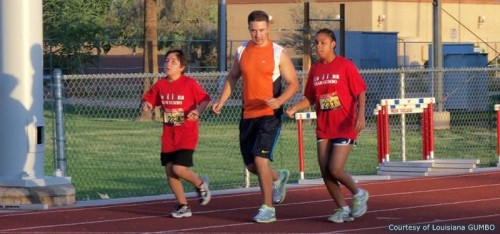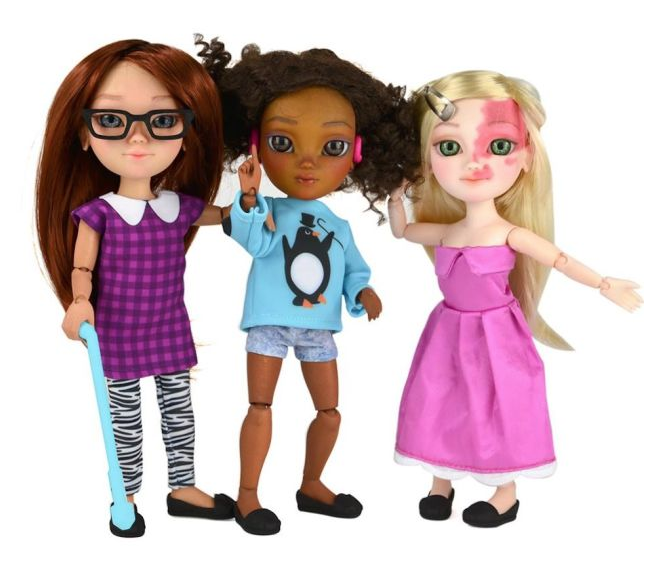
Gianni Toce, who competes in the T11 classification for visually impaired athletes with guide Matthew French and Lakeria Taylor (T11) warming-up at the 2012 National Junior Disability Championship.
Biweekly, USParalympics.org will spotlight one of the Paralympic Sport Clubs making a difference in the Paralympic Movement. Created in 2007 by U.S. Paralympics, a division of the United States Olympic Committee, the community based Paralympic Sport Club program involves youth and adults with physical and visual disabilities in physical activity and sports in their community, regardless of skill level. The program currently has 183 active Paralympic Sport Clubs in 46 states and Washington, D.C. To find Paralympic Sport Clubs and other adaptive, disabled and Paralympic sport opportunities in your community, visit the Paralympic Resource Network.
When Mitchell Miles attended his first archery clinic, he watched as athletes shot with incredible precision. Awe-struck, the Dodson, La. native never thought he would be able to do the same.
“I can’t do that. I can’t do that,” Miles said.
Shooting can be difficult for anyone who has never tried it, and especially for someone like Miles who has barely any feeling throughout the right side of his body.
Yet, after watching a girl with one arm draw the bow with her teeth he thought, “Yes, I can do this.”
Three years later, the 19-year-old employs the same technique. His skills have even garnered the attention of national team coaches.
Before Miles discovered archery, he was competing in track and field events hosted by Louisiana GUMBO (Games Uniting Mind and Body), a program that provides athletic opportunities for children who have physical and visual disabilities.
For years, children with disabilities have been able to play sports through their schools, local recreation centers and community organizations. However, playing at a competitive level can be challenging when kids have to contend with able-bodied athletes. Oftentimes, the only other option is a sport program specifically for children who have intellectual disabilities or have a closely related developmental disability.
Therefore, athletes like Miles seem to be in a league of their own.
Seeing a need for adaptive sports competitions, former University of New Orleans professor Dr. Jo Ellen Cowden came up with the idea of Louisiana GUMBO in 1985. With support from Janice Fruge, an education consultant for the Louisiana Department of Education, and a grant from the LDOE, the program was soon developed and hosted its first GUMBO Classic track and field competition.
It was designed to level the playing field and provide a safe environment in which children, despite their physical disabilities, could be active and treated equally. After gaining interest throughout the state and the support of wheelchair sports consultants Sis Theuerkauf and Phil Carpenter, the program grew tremendously.
Since becoming the program’s coordinator 18 years ago, Pam Carey says that providing children with the same experiences as their able-bodied classmates, friends and siblings has always been the priority.
“Sometimes they are treated differently,” Carey said. “I am trying to change that.”
Many of the athletes have spina bifida, cerebral palsy, muscular dystrophy or visual impairment.
“They just walk differently or they get around differently, but they’re just regular kids.”
While they may utilize leg braces or wheelchairs or receive assistance from a sighted person, Carey says that “they’re athletes, not kids with disabilities.”
Carey serves as both the coordinator of Louisiana GUMBO and the executive director of Louisiana GUMBO Inc., the nonprofit organization that helps provide funding for disabled sport opportunities.
Over the years, Louisiana GUMBO has grown to encompass four regions throughout Louisiana and offers athletic competitions in addition to clinics and training for athletes, coaches and officials.
Children who are between the ages 5-18 and who have a physical or visual impairment are eligible to compete. Students who are between the ages of 19-22 may also participate as long as they are enrolled full-time in a public school special education program.
“It always has been important that we provide them with a program that is similar to what they do in school,” Carey said.
Every spring, Louisiana GUMBO holds four regional track and field meets. Kids must then qualify to go to the state competition in the fall.
While competitions are an integral part of the program, Carey says that their goal is to help the kids enhance their self-esteem and to become independent. Like all organized sports, they help teach kids essential life skills such as how to learn and abide by rules and how to set and accomplish goals.
“It’s important that kids learn how to win and how to lose. That is what life is about. It’s not just about winning.”
Miles knows all too well the benefits of playing sports. In addition to competing in archery and track & field, the Dodson, La. native plays basketball. He says that sports can be very empowering.
“You learn that you can do anything you want to do and be a great leader in life.”
At just three days old, the Dodson, La. native suffered a stroke. However, he doesn’t let the effects it had on his body hold him back.
This past track and field season, he set national records in the javelin, discus and shot put events. He will soon head to Chula Vista, Calif. to train with U.S. Paralympics coaches at the U.S. Olympic Training Center. In August, he will represent the U.S. at the International Wheelchair and Amputee Sports World Junior Games in Puerto Rico.
Miles says that he wants children to learn how important it is to have a positive attitude and to embrace the challenges in life. He says that an athlete’s physical state is irrelevant.
“I tell them to never give up. Never give up. Just work hard and dream big.”
He acknowledges that he would not have these opportunities had it not been for Carey’s guidance and Louisiana GUMBO Inc., which has been designated a Paralympic Sport Club by U.S. Paralympics.
Support from the Louisiana Elks Association, Families Helping Families at the Crossroads Louisiana, the Louisiana High School Athletic Association, the LDOE and several dedicated community members, ensures that athletes can participate in events at no cost and have access to various resources.
The program is no longer funded by a grant, but is under a contract. Still, it remains a success and has been able to expand to include archery, boccia and powerlifting, in addition to track & field.
In the 28 years of Louisiana GUMBO’s existence, five athletes have gone on to compete in the Paralympic Games. Carey currently has a handful of athletes who are hoping to make the U.S. Paralympic Team and compete at the Rio 2016 Paralympic Games.
In the meantime, she hopes to continue expanding the program, nurturing the skills of young athletes and introducing more kids to the powerful world of adaptive sports.
“I am a strong advocate of what they can do, not what they can’t do.”


